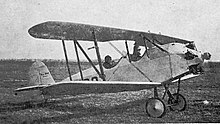| S 24 Kiebitz | |
|---|---|

| |
| S 24 left, Daimler L.20 right | |
| Role | Sport aircraftType of aircraft |
| Manufacturer | Focke-Wulf |
| First flight | 1928 |
The Focke-Wulf S 24 Kiebitz (German: "Lapwing") was a sport aircraft built in Germany in the later 1920s. It was a single-bay biplane of conventional design with equal-span, unstaggered wings, braced with N-type interplane struts. The pilot and a single passenger sat in tandem open cockpits, and it was fitted with a fixed tailskid undercarriage. The wings could be folded for transportation or storage, and the aircraft was designed to be towed by a car.
In 1929, the S 24 set a world distance record in its class of 1,601 km (995 mi) and in 1931 was used by Gerd Achgelis to win the German aerobatic championship.
Specifications (S 24)

Data from Jane's all the World's Aircraft 1928
General characteristics
- Crew: 2
- Length: 6.25 m (20 ft 6 in)
- Wingspan: 8.9 m (29 ft 2 in)
- Height: 2.25 m (7 ft 5 in)
- Wing area: 19.5 m (210 sq ft)
- Empty weight: 350 kg (772 lb)
- Gross weight: 570 kg (1,257 lb)
- Powerplant: 1 × Siemens-Halske Sh 4 5-cylinder air-cooled radial piston engine, 45 kW (60 hp)
- Propellers: 2-bladed fixed pitch propeller
Performance
- Maximum speed: 140 km/h (87 mph, 76 kn)
- Landing speed: 65 km/h (40 mph; 35 kn)
- Service ceiling: 4,300 m (14,100 ft)
- Rate of climb: 21.1 m/s (4,150 ft/min)
- Time to altitude: 1,000 m (3,300 ft) in 7 minutes
References
- Grey, C.G., ed. (1928). Jane's all the World's Aircraft 1928. London: Sampson Low, Marston & company, ltd. pp. 136c.
Further reading
- Taylor, Michael J. H. (1989). Jane's Encyclopedia of Aviation. London: Studio Editions. p. 395.
- "Focke-Wulf "Kiebitz"". Flight: 320–21. 18 April 1929. Retrieved 2008-03-23.
| Focke-Wulf aircraft | |
|---|---|
| Company designations, pre-1933 | |
| Names | |
| RLM designations, 1933–1945 | |
| Company designations, post-1945 | |
| Projects | |